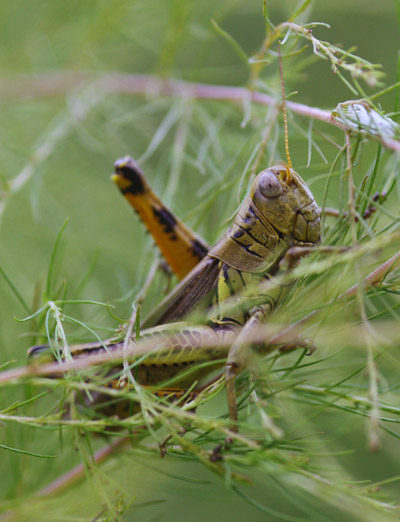Some time back I created the ‘Ask an Atheist’ page linked above, prompted by a similar effort elsewhere, to provide anyone the ability to fire away with any questions they might have regarding atheism, secularism, or perhaps just my own personal outlook on some issue. Some time after that, I amended the initial paragraphs to reflect the bare fact that very few people ever bother to try and determine what atheism really is; they just assume they know. And very often, this assumption is dead wrong, and to prove at least a portion of the old saying true, they succeed in making an ass out of themselves, anyway.
So for giggles, I’m adding this post, which will review the claims about atheism that I’ve seen most often (though not in any particular order – I’m not that anal); if I miss any, feel free to chime in. And provided that the ones who need it the most actually stay to read what’s here, it might help a smidgen. I realize the probability of this is low, but hey…
Atheists are just repeating what they’ve been told to say by their parents – While there are cases where this undoubtedly exists, to believe that it is a defining trait of atheism is way off base; it’s not hard to find the conversion stories on any forum that even touches on the subject. The various ‘Out’ campaigns exist because of the large number of atheists who feel compelled to keep their beliefs from public view, obviously not a sign of a supportive household, and the rising number of atheists and ‘Others’ means that a certain percentage of them were not raised that way. It certainly is not true for me personally; my dad still does guest sermons at his church(es), and I haven’t even been disowned.
Interestingly, a pretty high percentage of religious folk are following in exactly the same faithful footsteps of their parents and community, so I’m confused: is this a bad practice, or a good one? Or is it one of those double-standards that I keep hearing of?
Atheists are just mad at god – It’s funny the number of times I’ve heard this, considering how ridiculous it is. Atheists don’t believe in god – does it really make sense to be mad at something imaginary? Oh, no, wait – we all really do believe, but we’re simply denying it because we’re mad? Does that even make sense? What are we mad about? All the good stuff he does? Or that there’s bad stuff too that we won’t dismiss with lame excuses? Seriously, I’m hoping someone who’s uttered this one can explain it to me.
This is one of the many condescending arguments, however; the implication that we have adopted an entire worldview because we’re petulant. This condescension is quite common, too.
Atheists are satanists – Even worse than the one above, so it’s surprising how often it appears as well. But no – atheism wouldn’t be so fucking asinine as to dismiss god but keep the attendant anti-god. It’s kind of a no-brainer, which doesn’t say much for those who forward it.
“But if you haven’t accepted god into your heart, that opens the door for satan!” Or whatever variation you wish to use – sure, whatever. I’ve addressed this in detail to cover all of the salient points not long ago, but in short, it’s a weak posit without any supporting evidence or even a logical premise.
Atheists are immoral – Because, you know, only religion can possibly provide moral guidance. Curiously, in various tests and polls that have been given, atheists have shown distinctly stronger moral tendencies, most likely through knowing the difference between morality (which by definition involves other people) and obedience, which does not assume any morals automatically. Not to mention that applying a label to oneself does not actually confer any properties – morality is shown through behavior, not title.
Atheists are nihilists – Because, you know, any meaning to life at all has to come through religion, despite the fact that most religions are either vague on the topic, or in conflict, or provide one that doesn’t stand up to scrutiny. Meaning, however, is a personal thing, while still buttressed by the inherent desires common throughout our entire species. Nihilism is actually a pretty bizarre concept, one that I’m willing to bet cannot be shown to be held by anyone.
Atheists are hedonists – Because only god’s grace prevents us from being selfish, it would seem. While this one has the barest anecdotal support in the frequency of the stories of those who lived such a lifestyle before they “found god” (I’m guessing in the sofa cushions,) this is largely a misunderstanding due to oversimplification. Few former self-admitted hedonists were atheists, or failed to believe in god – they simply didn’t bother with religious behavior.
There are a few issues within all this, however. The first is, humans by nature act only to satisfy their desires, period. It’s just that a lot of desires are not selfish. Second, hedonism is another bizarre concept that cannot really be quantified, and is usually defined as desired (ironically.) And finally, the religious concept of salvation is actually pretty selfish in itself, as is the inordinate privilege assumed far too often. Let’s face it: every time we find someone who wants to dictate their faith to others – what the schools can teach, what people can do with their bodies, what laws should be, who has the right to speak against faith, and on and on – we’re not exactly talking altruism, are we?
Meanwhile, atheism speaks nothing to self-indulgence in any way, and secular humanism places it well behind the welfare of others.
Atheism is just as much a faith as any religion – This one is often addressed by saying that by the same logic, not collecting stamps is a hobby. But simply put, no one has faith that there is no Vegemite in the cupboard; they know there isn’t because there is no positive evidence that there is. Duh! Atheism is a term only because of the prevalence of religious belief; we don’t need to define the absence of anything else in our lives in a specific way. But damningly, faith is a requirement of religions specifically because of the lack of evidence; it is the denial that this lack is indicative of absence. Conversely, atheism is the acceptance of it.
There are three relevant observations here:
1. Aren’t we constantly told faith a virtue?
2. If both belief and nonbelief are a matter of faith, what value does faith possibly have?
3. Why does this insipid binary argument come up so often? We don’t consider every imagined premise to have merit when there’s no evidence for it – but this is supposed to be a solid argument in religious circles. Just because ‘supernatural’ is a term, rather conveniently excusing any need to show evidence, this doesn’t mean that it’s a valid concept.
Atheism is fostered by college professors – This one almost has a smidgen of truth to it while still being wrong. I have heard of only one college professor who has made such an argument (and I’m not even sure about that one,) which is a far cry from being a concerted effort in higher education; considering that religious folk can get their panties in a twist over prayer banners being taken down in schools and all that, I can’t imagine how anyone thinks the majority of colleges actively teaching against religions wouldn’t cause holy wars, but yeah, so many of these arguments only show a dismal lack of sense. The smidgen bit comes in, however, as students learn how things really work, and how many traits that they assigned to their gods are readily explained by physics, and in fact may be really easy to accomplish without (and often demonstrated.) And while it is true that the religious student that attempts to repeat the blind assertion tactics that they’re used to hearing from their churches may at times get their ass handed to them, this is notably different from actively proselytizing atheism. Meanwhile, those little verities vouchsafed by their holy leaders are shown to be bold-faced lies, which certainly doesn’t help matters any. Naturally, to prevent the lies from being revealed, holy leaders have to keep their flock away from such sources of info, and so we learn what “demonization” actually means and how this belief even arose.
By the way, the waning of faith upon exposure to college most often comes not from the professors, but through other students, who are often much more blunt about the topics (or any topics.)
Atheists have their own high priests – What, you mean, like damn near every church in existence? Good heavens! Somehow, behavior that the religious engage in constantly, that even defines “religious,” becomes detrimental if atheists are accused of engaging in it, which has always confused me. No, that’s not true – I simply put it down to people who cannot make a decent argument to save themselves (a ha ha.)
The high priests of atheism are, it seems, people like Richard Dawkins, Daniel Dennett, Jerry Coyne, and so on. You know, the ones given exalted titles, holding their own services, issuing dire consequences of not following their lead, soliciting money from followers, and all that stuff. Apparently, anyone who has gained any recognition of their views can now be considered a priest – which pretty effectively makes the title next to meaningless, doesn’t it?
It is worth knowing, and highlighting, the difference between the tactics of religious leaders and pretty much everyone else (save for fascist dictators.) Only religious leaders state “Truths™” that can never be demonstrated; only religious leaders discourage questioning of their assertions; only religious leaders promise dire punishments for failing to follow their instruction. And they pretty much have to, because everyone else is capable of presenting a decent argument and has no use for fear-mongering.
There are probably more that I’m just not thinking of right now, but that’s a good start anyway, and all of these are surprisingly common.
You may have noticed that most of these claims are actually pretty condescending, assigning superficial thought processes to atheists as a whole; the irony is almost palpable when the claims are as facile and naïve as these. I’ve heard, countless times, the old complaint that, “atheists never address sophisticated theology,” which I guess is theology that knows what wine goes with what cheese – I have yet to see any form of theology that doesn’t assume the posit, so we can’t be using the term to define an objective and conscientious approach. In contrast, atheism is not sophisticated or nuanced at all; it’s amazingly simple, and can be summed up pretty quickly: every religion is considered as mythical, nonsensical, and flawed as every other. Yet a ridiculous number of people cannot seem to grasp this, and most especially assume that anyone disagreeing with them must be an idiot. Because, you know, religious belief is always arrived at through careful and lengthy consideration…
There is a positive side to all of this, though. Every religion places emphasis on both truth and ethics, and churches can disseminate information on a weekly basis. With multiple sources demonstrating the fallacies of these assumptions, we can expect to see them disappear very quickly as those religious folk who had been repeating them correct themselves. So it won’t go on much longer.




















































 So, right outside the same porch mentioned in the previous post has been a pair of large orb webs occupied by
So, right outside the same porch mentioned in the previous post has been a pair of large orb webs occupied by  What I found was a vintage barn or railroad lantern, and it arrived in “as found” condition, complete with old spider egg sacs (barely visible to the lower right of the chimney.) It took a while to clean up, and the kerosene had stained the enamel around the base, but I figured that just added to the rustic charm. Despite the grime, it was in good enough condition that I could have filled it and lighted it immediately, and I debated about cleaning it up and reselling it, but I liked the look of it too much. Once cleaned, I removed the wick assembly and drilled a large hole in the bottom of the kerosene tank, then fed the lights up through the bottom and clustered them within the glass chimney. From discussion to result was less than two weeks, and from arrival to display less than two hours.
What I found was a vintage barn or railroad lantern, and it arrived in “as found” condition, complete with old spider egg sacs (barely visible to the lower right of the chimney.) It took a while to clean up, and the kerosene had stained the enamel around the base, but I figured that just added to the rustic charm. Despite the grime, it was in good enough condition that I could have filled it and lighted it immediately, and I debated about cleaning it up and reselling it, but I liked the look of it too much. Once cleaned, I removed the wick assembly and drilled a large hole in the bottom of the kerosene tank, then fed the lights up through the bottom and clustered them within the glass chimney. From discussion to result was less than two weeks, and from arrival to display less than two hours. It looks quite nice in place, and my only regret is that it is not self-contained and running from batteries, with that fill-spout serving as the power switch. Even during the day, it produces a nice effect, but at night it really comes into its own. I know there are some people that think multi-colored lights are garish or old-fashioned; good for them. We’re pleased with the ensemble, and that’s the only criteria we need.
It looks quite nice in place, and my only regret is that it is not self-contained and running from batteries, with that fill-spout serving as the power switch. Even during the day, it produces a nice effect, but at night it really comes into its own. I know there are some people that think multi-colored lights are garish or old-fashioned; good for them. We’re pleased with the ensemble, and that’s the only criteria we need.
 Looking at how the day is shaping up out there, it seems like this is a pink kind of day, so this image has been specially chosen to fit in with the conditions.
Looking at how the day is shaping up out there, it seems like this is a pink kind of day, so this image has been specially chosen to fit in with the conditions.
 Yes, it’s still been a slow couple of weeks, and I’ve been working on some other projects, so the photography is leaner. Hopefully this is not yet the start of the downward trend that autumn brings.
Yes, it’s still been a slow couple of weeks, and I’ve been working on some other projects, so the photography is leaner. Hopefully this is not yet the start of the downward trend that autumn brings.

 The storm may also have been responsible for the presence of a great egret (Ardea alba) at the pond these past few days, having been driven out of its normal range by the winds. I was used to seeing them in Florida all over, and along the NC coast, but haven’t seen one in this area in a long time. I’m not sure what the resident great blue heron thinks about this newcomer – it’s been the sole big wader for the entire pond, though I have spotted smaller ones for only a day or so – but the pond is big enough to support them both, and the green herons and others. We’ll just have to see if this one decides to stick around. It seems less wary than the great blue – this image was acquired with some very basic stalking – so if it remains for a bit, I might be able to do a more rounded gallery of images.
The storm may also have been responsible for the presence of a great egret (Ardea alba) at the pond these past few days, having been driven out of its normal range by the winds. I was used to seeing them in Florida all over, and along the NC coast, but haven’t seen one in this area in a long time. I’m not sure what the resident great blue heron thinks about this newcomer – it’s been the sole big wader for the entire pond, though I have spotted smaller ones for only a day or so – but the pond is big enough to support them both, and the green herons and others. We’ll just have to see if this one decides to stick around. It seems less wary than the great blue – this image was acquired with some very basic stalking – so if it remains for a bit, I might be able to do a more rounded gallery of images. I can’t say if the storms had the slightest to do with these, all I can say is that abruptly, several individuals of this unidentified grasshopper could be found with little effort, when I have been seeing virtually nothing of the sort in the area before. These are big enough to be called ‘locusts,’ better than 5cm in overall body length, and while capable of doing a lot of plant damage, I suspect they won’t last long against the large number of birds and the nearby black-and-yellow argiopes (which have been chowing down on dragonflies and cicadas, and would probably relish the change of diet.)
I can’t say if the storms had the slightest to do with these, all I can say is that abruptly, several individuals of this unidentified grasshopper could be found with little effort, when I have been seeing virtually nothing of the sort in the area before. These are big enough to be called ‘locusts,’ better than 5cm in overall body length, and while capable of doing a lot of plant damage, I suspect they won’t last long against the large number of birds and the nearby black-and-yellow argiopes (which have been chowing down on dragonflies and cicadas, and would probably relish the change of diet.) I close with another crab spider, even smaller than the previous, remaining inconspicuous on the underside of a delicate white flower – I haven’t pinned this down for sure, but the flowering vine might be virgin’s bower (Clematis virginiana.) I’m going to have to confirm this because it produces a lot of flowers that we could use around the yard, and thus attract more insects and perhaps hummingbirds. Granted, bigger flowers are more likely to attract the
I close with another crab spider, even smaller than the previous, remaining inconspicuous on the underside of a delicate white flower – I haven’t pinned this down for sure, but the flowering vine might be virgin’s bower (Clematis virginiana.) I’m going to have to confirm this because it produces a lot of flowers that we could use around the yard, and thus attract more insects and perhaps hummingbirds. Granted, bigger flowers are more likely to attract the 